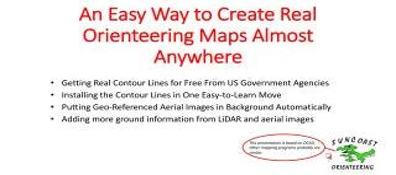A Recipe Book for Healthier Clubs?
Gord Hunter
I’m excited about the idea of a club president’s forum to discuss ideas for growing orienteering both at the club and national levels.
I have another idea that I’d like to float here. Rick Worner and I talked about it on the weekend. Rick reminded me that the idea is not entirely new, that for years Don Davis wrote a column in Orienteering North America where he featured news and good ideas coming out of clubs across America. I know someone in O-USA went to a lot of trouble to digitize and display the ONA’s from the ‘Berman era’ but now they seem nowhere to be found. Too bad.
The idea I had is slightly different. Anyone of a certain age has probably been involved in putting together or buying a cookbook, a collection of recipes of things to eat. The organization putting out the recipe book was probably doing it to raise money. Even Orienteering Canada got into the act and produced a book called Fit to Eat. If you can find it on eBay grab it. It was good. BUT I DIGRESS!.
What I suggest is that we, the orienteering clubs of America, start contributing to a central core, a recipe listing of things that can help our clubs grow because THEY HAVE HELPED YOUR CLUB GROW or in some way HELPED YOUR CLUB DO THINGS BETTER, MEET A MARKET DEMAND or the like.
So how about it? Would you like to chip in a ‘recipe’ that may help another orienteering club? I’m sure space could be found in a member’s section of the O-USA web page for our 'cookbook'.
What would you possibly write about? Well, without taking too much time, listed below are some ideas that I think would find an appreciative audience somewhere in this big country.
How would you write? Well first I think some would have to put aside your phone and dust off your computer. Smart phones are just not good for writing instructional pieces. Second. Look into what you know and what your club has been doing that has captured your attention. Are you having a youth training program? Working with Parks Department? I’d sure love to know how you got that going and what it takes to keep it going. Tapping into the Home School market? Ditto.
Here below are some of the ideas that strike my fancy. Pick one or a few and write up what is working for you guys. “What is working”. Please resist the temptation to say ‘that won’t work’ Every idea will work, EVERY IDEA, if the right person is pulling the levers. Feel free to add topics that would interest you.
Benefits of having a growing program.
How to tap into the Boy Scout/ Girl Scout market
How to tap into the Home School market
How to tap into and grow the JROTC market
Recruiting and rewarding volunteers
How to develop and stage urban orienteering events.
Competitive vs non-competitive orienteering- Is there room for both?
Can we bring back team competitions to an individual sport? Why? How?
Building and maintaining better websites
Building and maintaining a youth program + tapping into the volunteer power stored in the parents of youth program participants
Building and maintaining adult training sessions
Getting more maps of more parks at a cheaper price.
A Greeter program for orienteering events: Why? How?
Humor and Orienteering – a collection of funny incidents to place on websites.
How to approach park managers and land owners for event permissions
Sprint orienteering and how to make what could be a +/-
15-minute event into something more worth the trip.
Janet Tryson
Janet T.
On Sep 26, 2022, at 6:34 PM, Gord Hunter <gor...@rogers.com> wrote:
--
You received this message because you are subscribed to the Google Groups "ClubNet" group.
To unsubscribe from this group and stop receiving emails from it, send an email to clubnet+u...@orienteeringusa.org.
To view this discussion on the web visit https://groups.google.com/a/orienteeringusa.org/d/msgid/clubnet/1054229158.1016398.1664231633270%40mail.yahoo.com.
RWorner LKohn
Joseph Huberman
- SI boxes are attached to the controls which are hung from trees.
- All our registrations are online, we collect no money on site.
- We use the SI-Droid app on a tablet to run our events.
- We have the option to schedule our participant arrival windows so we don't have a crush of people arriving all at once.
- We have our beginner class skills on very short videos so we can answer beginner's questions individually instead of holding a class if the event director so chooses.
- Event directors have the freedom to hold any type of event they want and what skill level they want to attract. We have:
- "Open" events for everyone with White through Red or Blue (70-100 participants)
- "Advanced" events where the participant has completed an Orange or above course (20-30 participants)
- "Expert" events where the participant completed a Brown or above course. (15-20 participants)
- It is much less work to hold an Advanced or Expert course, so the ratio is about one open to two or three Advanced or Expert events.
- Radio Orienteering about 10 events per year (5-12 participants)
The event directors have total control when designing their events. They can have as many or as few courses as they choose, and decide the skill levels. They can have mass or individual starts and can control the number of people arriving per hour. They produce some original event formats because they are creative and free to run the event any way they want. Event directors write their own event announcements and results articles and post them to our Wordpress website. We use Ecwid storefront for registrations because it is super flexible and attaches to PayPal. They use our Members (workers) email list to get any help they want. There are always people ready to help when needed.
================================
Joseph Huberman
Raleigh, NC
To view this discussion on the web visit https://groups.google.com/a/orienteeringusa.org/d/msgid/clubnet/CAGTzKr7WZ_t%2Bin33FBg9ebp9GQWp-9rhOk0L7YN80aRi8OoG6A%40mail.gmail.com.
Gord Hunter
Gord Hunter
- US federal agencies have a great store of freely available LiDAR covering most of the country.
- The agency LiDAR, particularly that from NOAA, makes moving the LiDAR into an orienteering map a one-step process. It is very quick and easy, so easy that no club should ever again be paying anyone to produce a base map.
|
pgwo...@gmail.com
Gord has done a great job here. Because he has helped people in the past, he knows what the sticking points are and how to talk about them. He points to the needed resources and what to do with them. With the information that he shows you how to get, field checking is much, much easier and doesn’t require as much time or, I will also say, skill. Old time mappers working with information about contours and such taken from aerial photos spent a huge amount of time in the woods and really needed whole toolbox to make a good map. Gord has shown what is now possible and how people can now make maps in much, much less time. Yes, when there are large areas of forest, you have to be able to use the LIDAR but the contours that it provides make mapping much easier.
Well done Gord and I hope more people take on mapping projects. It is actually a great quite time in the woods, too.
From: clu...@orienteeringusa.org <clu...@orienteeringusa.org> On Behalf Of Gord Hunter
Sent: Wednesday, December 28, 2022 1:55 PM
To: ClubNet <clu...@orienteeringusa.org>
Subject: [OUSA-ClubNet] A contribution to A Recipe Book for Healthier Clubs
For about 12 years now I have been making orienteering maps to support Suncoast Orienteering and Florda Orienteering as well as schools, scout groups and individuals across America.
Well, when it comes to maps outside Florida that help stops before the field work stage.
Recently two things have become obvious to me and caused me to refine/ streamline some of my processes.
- US federal agencies have a great store of freely available LiDAR covering most of the country.
- The agency LiDAR, particularly that from NOAA, makes moving the LiDAR into an orienteering map a one-step process. It is very quick and easy, so easy that no club should ever again be paying anyone to produce a base map.
Fieldwork? Now that is time consuming and if you don't have a volunteer expect to pay but the good news is that the new base maps make the fieldworkers jobs easier and quicker and therefore should cost less.
After reading about one person's plea on a club Facebook page for advice on how to make an orienteering map in his area and cringing while he basically got brushed off, I stepped in to help. After spending some 60 minutes on the phone walking him through the steps - good thing he was a very fast learner- he got his map and I got the idea to collect it all in a slide show.
I got some help from the head of NOAA and my contact at OCAD and a couple of individuals in GAOC.
Here is my new mapping slides show. An Easy Way to Create a Real O Map.pdf
|
|
I hope you find it useful.
Yes there are other ways to bring all that information together and if you are used to them those ways will be easier for you.
But here I am confident that anyone with a fair bit of interest can become an orienteering mapper in a matter of hours.
Gord Hunter
Suncoast Orienteering
--
You received this message because you are subscribed to the Google Groups "ClubNet" group.
To unsubscribe from this group and stop receiving emails from it, send an email to clubnet+u...@orienteeringusa.org.
To view this discussion on the web visit https://groups.google.com/a/orienteeringusa.org/d/msgid/clubnet/1988150539.4765600.1672253701450%40mail.yahoo.com.


